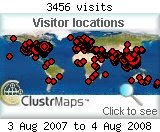Inquirer
Last updated 02:17am (Mla time) 09/02/2007
MANILA, Philippines -- Asia accounts for 60 percent of the world’s population, but about two-thirds of the global information flow comes from the developed countries. The imbalance has reduced the Asian voice to what an editor at China Daily calls “barely a whisper.”
Although Asia has become the engine for global economic development, its media continue to be overshadowed by Western media.
By their sheer size, American media companies dominate the global news and information industry, allowing them to frame many issues from their perspective.
To help address the imbalance, People’s Daily, China’s leading newspaper, hosted the First Asean plus 3 (10 + 3) Media Cooperation Forum on Aug. 21. Editors from the 10 members of the Association of Southeast Asian Nations (Asean), and from China, Japan and South Korea attended the forum in Tianjin, a city two hours’ drive from Beijing.
The forum focused on the role of media from East Asian countries in promoting 10 + 3 cooperation, strengthening Asian voice in the international arena, and building a win-win information platform for China and foreign media for the Beijing Olympics.
It was Chinese Prime Minister Wen Jiabao who proposed the holding of the forum at the 10th 10 + 3 Summit in Cebu in January.
To promote cooperation, editors suggested, among others, that exchanges and a network for information sharing be set up.
‘Develop our own forms of journalism’
By Qu Yingpu
I once heard a story I would like to share: In the town of Biratnagar in the Nepali terai—where the north Indian plains meet the foothills of the Himalayas—students were debating the impact of satellite TV on their lives.
One boy said: “I don’t like Star movies and Channel V. The life shown on these channels is far removed from the reality of our own country. Because of these channels, Nepali girls have started wearing short skirts.”
“I think films are much more dangerous to society,” replied a girl. “Nepali boys are very quick at imitating. That’s why we see boys wearing earrings, bandanas on their heads and teasing girls.”
It may not be a pleasant story, but is probably a fair reflection of the current state of Asian media.
Asia is the fastest-growing economic region in the world with a large population and abundant natural resources.
In 2005, the economies in this region continued to grow at a steady pace of 8.2 percent and continued at about the same rate in the first half of 2006, according to statistics from the World Bank. Since the early 1990s, Asia’s vitality has been boosted by regional cooperation, such as the Association of Southeast Asian Nations (Asean).
However, the development of Asian media does not reflect its economic dynamism. Asian countries account for 60 percent of the world’s population, but almost two-thirds of the information flow comes from the developed world, reducing the Asian voice to barely a whisper.
Developments in the media industry have been led largely by Western countries, whose international presence has overshadowed much of the Asia-Pacific media.
Asia, as the fastest-growing economy in the world and the engine for global economic development, deserves better media coverage by news organizations in the region and around the globe.
What implications will the global media integration have on Asia media?
Global media integration means the concentration of the press in fewer and fewer corporate hands and in a few countries. New communication technologies have made it possible for media giants to enter the lucrative Asian market to establish powerful distribution and production networks.
It will have serious and progressive repercussions not only on Asian media but also on cultural, social and economic development.
In many cases, media institutions survive on advertising revenues, which can lead to the media outlet being influenced by various corporate interests. At the same time, ownership interests may affect what is and is not covered. Stories can end up being biased or omitted so as not to offend advertisers or owners. When global media companies enter Asian countries, the attempt of building a new image of Asia will be in the control of Western media powerhouses. The voice of weak countries will never be heard.
It is about time for the Asian media to act together to prevent this from happening—like Singapore’s media regulations that disallow a single foreign entity from holding more than 3 per cent of a Singaporean media company. Otherwise, Asian media will be gobbled up like a McDonald’s Big Breakfast by Western interests.
Read the complete article here.
Bagong Simula sa Bayan ni Juan
Breaking News
For other news and information, scroll the links found on the sidebar. Links to other relevant sites and media blogs are located on the lower right portion. - RAFS76
Tuesday, September 04, 2007
Strengthening the Asian voice
Posted by PhilMADE at 3:56 PM
Subscribe to:
Post Comments (Atom)













0 comments:
Post a Comment